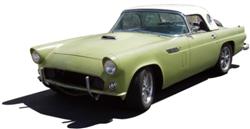This has been discussed on here any number of times - and there are more than a few that have made these modifications and found them to their liking. I believe in performing functional tests (an engineers disease) and tried the "hose on the manifold bypass port" test as soon as a guy mentioned it to me. Thunderbirds are particularly sensitive to heating (small radiator and inefficient WP mounting) and Tucson has heat to spare. Letting that much hot water constantly bypass the radiator (even after the engine was warm) wasn't to my liking.
I know that my T-bird responded immediately to changing to the high flow thermostat - as predicted by the CASCO test you see on their site. It amounts to simply putting more water through the same radiator. Charlie has recently reported that to get a good one - the thermostat that Milodon now markets, seems to have a quality edge. I've been using the Mr. Gasket parts - and the 160º has worked well - the 180º stutters a bit. You could also drill the auxiliary passages in a large poppet style T-stat such as sold by NAPA (170º) - probably have to fit them around the edges.
The "three hole" (drilled) Robertshaw style thermostat can be seen on the Stewart waterpump site - and yes they are unfortunately, Chebbie oriented - but they are very competent. They use the drilled thermostats with a performance engine set-up to have NO bypass. When I asked about this, Ted advised using an orifice that still allowed a small free bypass passage. For the good reason of allowing any bubbles to exit the water pump cavity when the engine was stopped. Fact is - engines with the two modifications purge quite nicely when you are filling them with fresh coolant.
Yes the modification slows down the warm-up period - again, no big deal in SoCal or Arizona or points south - but noticeable in Michigan. Ford also used a small initial spark advance and ported vacuum advance on these engines - which leaves them clunking along quite retarded at idle - which also speeds warm-up. Most of us have added more initial advance - which makes for better performance of the engine in general - but the increased advance also slows warm-up. The sum of this could make an outfit pretty "cold blooded" in the extreme - but I've had some pretty nasty engine combos in cold climates - and enthusiasts live with it. I know I did - it wasn't my wife's car.
I put the smaller WP pulley on my engine after realizing that at hot idle - water flow into the top tank was (to be polite) very sluggish. My last restoration project was a '67 Cougar (289 automatic) and at idle it easily showed twice the water flow as the T-bird. The remedy was to use the 289 size upper pulley - yes it jacks up the WP revs, but it didn't hurt the Cougar and it had a higher hot idle speed in drive. What then occurred was the fan speed was too high to suit me - so I went looking for a thermostatic clutch (Hayden). They fit nicely on a T-bird - not so nicely on a sedan.
The sum of this is - that making the car behave to suit ME - required some thought and testing and "re-engineering" to get what I wanted. This sure isn't the total number of changes I've made in the name of reliability or performance - and there are more to come I'm sure. If some of the things I've tried or tested can help another of us - I'm going to share them.

Steve Metzger Tucson, Arizona